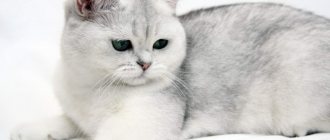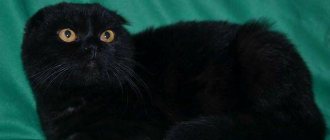Royalty can exist not only in human society, but also in the cat world. This postulate does not require proof; just look at the Russian blue cat . She exudes aristocracy, slight arrogance and elusive grandeur. A barely perceptible half-smile and a deep gaze make you think that in front of you is a creature much smarter and wiser than just a cat.
And even in appearance, the Russian Blue cat breed is distinguished by a high quality mark. Not all cat women can boast of model appearance. The beauty and chic of a shiny fur coat is emphasized by a bluish-blue tint, which, from a human point of view, has always been considered elite in the animal community.
History of the Russian Blue cat breed
Russian blue cat
Plush cats began their triumphal march across countries and continents from Foggy Albion, where they gained fame as unrivaled rat catchers. The “grandmother of all Europe,” Queen Victoria, was especially fond of blue-haired cats, at whose court many representatives of this wonderful family lived. History is silent about the routes cats took to reach Shakespeare’s homeland. The British breeders themselves are firmly convinced that their pets came to them from the Russian north, or rather, from snow-covered Arkhangelsk. It was rumored that the first mustachioed “Pomors” were presented to the British by Catherine II, who had the habit of presenting foreign ambassadors with all sorts of living wonders. Apparently, since then, an alternative name has been assigned to the breed - Archangel Blue.
In 1893, British breeder Karen Cox decided to “pump up” the breed qualities of Arkhangelsk cats a little and went to their supposed historical homeland - Pomorie. There the breeder managed to get hold of several kittens, which became the successors of the family of green-eyed “archangels.” As for official recognition, it came to Russian blue cats only in 1912. 19 years after Mrs. Cox’s voyage, felinological associations finally approved a separate standard of appearance for animals, thereby equalizing their rights with representatives of other cat breeds.
After World War II, the Russian Blue cat clan withered and was on the verge of extinction, which greatly alarmed European breeders. Enthusiastic breeders from Britain, Finland, Sweden and Denmark rushed to restore the number of “archangels”. And since finding a sufficient number of purebred individuals for mating turned out to be an impossible task, Russian Blues began to be crossed with representatives of other breeds that had a similar color. So the Arkhangelsk mousecatchers became related, first with the Siamese, and then with the British.
They stopped breeding Russian cats with oriental cats in England quite soon. The reason for stopping the experiments was the inheritance of external defects and behavioral deviations by the offspring. The kittens' character deteriorated, they became too nervous, meowed loudly, and as they grew older, they began to love marking corners. But breeders from the USA were not embarrassed by such transformations and they continued their breeding research. As a result, the American branch of the Russian Blue breed was born, the representatives of which had a pronounced oriental appearance, typical of representatives of the Siamese group.
The Russian Blue cat breed came to Russia during perestroika times. Domestic breeders did not think long about where to get purebred “material” for mating, and began to cross foreign individuals with native cats of the same color and build. The experiment, oddly enough, turned out to be successful, and already in the early 90s, Russian nurseries began to offer the first Arkhangelsk Blue kittens for sale.
Interesting facts about the breed
- The Russian Blue cat was originally called the Archangel cat in England, after its place of birth.
- Russian Blue cats are silent and very rarely meow quietly, even as adults they are cautious and shy.
- The breed was brought to England for Queen Victoria and was first shown in 1875 at London's Crystal Palace.
- They have a dense, very thick undercoat, so that skin glycoproteins almost do not get out, which makes the breed anti-allergenic and favorable for allergy sufferers.
- A distinctive feature of the breed is its love of heights and jumping from there; to prevent falls, it is better to remove all vases and other breakable objects away.
Appearance of a Russian Blue cat
Russian blue kitten
The Russian Blue cat is the embodiment of grace and sophistication. Representatives of this clan are easily identified by their graceful posture and stately “ballet” gait. The second identifying feature of the breed is its dense velvet coats of bluish-ash color. It is thanks to the soft fur, distant from the body, that the silhouette of the animal acquires additional expressiveness and exquisite charm.
Depending on the place of breeding, there are three main types of appearance of Arkhangelsk blues:
- American (TICA standard) - oriental type, characterized by a wedge-shaped skull, large unfolded ears and a double coat of bright blue color;
- European (WCF standard) - with a flat skull and thick coat of a uniform blue tone with a silver tint;
- English (GCCF standard) - with a short wedge-shaped head and dense light blue fur covered with a silvery “patina” (silvering).
Head
According to the standard approved by the World Cat Federation (WCF), representatives of the Russian Blue breed must have a flat, moderately elongated skull and a straight nose, smoothly turning into the same even forehead and forming a slight bulge at the level of the eyebrows. The chin should be strong and rounded. The whisker pads are distinct and moderately convex. The tone of the lobe is gray-blue.
American type Russian Blue cat
European type of Russian Blue cat
English type Russian Blue cat
Eyes
Muzzle of a Russian Blue cat
Large, oval, rich green. Set wide apart.
Ears
Quite large, tilted forward. The tip of the ear looks slightly pointed in “Americans” and more rounded in “Europeans”. The ear tissue is thin and elastic. The inner part of the ear funnel is slightly pubescent.
Neck
The neck of the Russian Blue cat is elongated and graceful.
Frame
The cat's body is muscular, slightly elongated, and medium in size. For American cat breeds, a lightweight (oriental) body type is considered the standard.
Limbs
Legs are long and straight. The Russian Blue's paws are oval, with soft, elastic pads of lilac-pink color. The “Americans” have pinkish-beige pads.
Plush paws
Tail
The cat's tail is long, well-furred, with a rounded tip.
Wool
Mom with kittens
The coat of “Europeans” is short, stands up like a beaver and gives the impression of being very thick due to the equal length of the undercoat and outer hair. American fur coats have a plush texture.
Color
The ideal Russian Blue, from the point of view of the WCF Commission, should have a uniform mid-tone blue color with a slight silver tipping. The TICA standard prescribes a bright blue color type with a subtle silver tint for its pets.
Possible defects
One of the most common defects is a discrepancy between the coat color and the generally accepted standard. For example, even a purebred cat is capable of producing offspring, among whom will be a baby with a spotted coat. The reason for such a marriage is the play of genes, so it is almost impossible to predict the likelihood of the birth of “wrong” kittens.
Serious disadvantages of the breed include a knobby, kinked tail, an incorrect bite, and bulging or too deep-set eyes. Championship is not possible for individuals with a sagging spine, strabismus, or fur that fits tightly to the body. Polydacts, cats that have undergone onychectomy (declaw surgery), animals with color defects (spots on the fur with an area of more than 1 cm) and aggressive individuals are subject to unconditional disqualification.
Castration and sterilization
Castration/sterilization is an operation to remove the sex glands. This procedure is carried out in a number of cases:
- breeder (if the animal is not allowed for breeding);
- owner of a pet (if kittens are not needed);
- for medical reasons.
At the initiative of the breeder, it is possible to sterilize a cat that is not a carrier of a pure phenotype. For example, if a cat has a white spot in its color or there are doubts about its thoroughbred. To avoid spoiling the purity of the breed, a cat with disorders should not give birth. The same goes for cats. The owner of a domestic cat can initiate neutering to prevent the cat from suffering during heat. Females try to preserve women’s health in cases where kittens are expected from her. And if the owner does not need such a replenishment, then the cat will be sterilized. And cats are sterilized for the reason that they mark their territory (because of this, there can be a strong unpleasant smell in the apartment).
Russian blue cats are very showy animals, but like any other cats, they can mark their territory
A veterinarian can give medical indications. For example, if a female is diagnosed with a female disease (this usually happens at an older age). This operation is inexpensive (from 1000 rubles).
At what age is it recommended to do it?
If we are talking about kittens in a nursery, then the owner of the organization can organize sterilization even for small kittens (3-4 months). But this is not entirely correct. Surgery to remove the gonads is recommended after the internal organs have formed. If, for example, the cat’s internal systems have not yet fully formed, then after the operation they will not form correctly. In practice, cats begin to be sterilized at approximately 8–9 months.
My cat was spayed at the age of 9 months. I was worried that this would affect her future health, but there was no choice. The drops recommended by the vet did not help. The animal feels great, is also active and cheerful. Once every six months we go to the veterinary clinic for preventive care - the cat is healthy.
Video: how to care for a cat after surgery
Photo of Russian Blue cat
Personality of the Russian Blue cat
Russian Blue in the arms of the owner
Russian Blue-haired cats can be classified as problem-free pets. Whims, self-will, deliberate sabotage - all this is beyond the understanding of plush aristocrats. Thanks to their innate intelligence and exceptional sensitivity, Arkhangelsk cats give the impression of being somewhat dependent, but one cannot accuse them of being too soft. Russian blue cats are sweet and spontaneous only with their own household. This rule does not apply to strangers and unfamiliar people, so do not be surprised if, upon seeing guests on the threshold, your pet immediately makes a move.
It is believed that representatives of this breed are lenient towards children's pranks and do not lose their composure in situations in which any other cat would have long ago released its claws and issued a battle cry. However, leaving a small child and an animal alone is always an unjustified risk. In relation to other pets, “archangels” are quite loyal. Moreover, cats are ready for a peaceful dialogue with any representative of the fauna, unless he makes attempts to provoke.
The Russian Blue cat’s favorite place is not the owner’s lap or even a well-appointed MDF house, but any piece of furniture at least one and a half meters high, which, like Everest, is subject to immediate (and often repeated) conquest. As for affection, the mustachioed intellectuals accept it quite favorably, but they will not allow themselves to be squeezed to the point of fainting. In addition, in the soul of even the laziest Arkhangelsk cat, a primitive hunter is lightly dozing. This means that getting a mouse or other unwary rodent for a pet is a matter of honor.
In the absence of conditions for full-fledged hunting (applies to individuals living in city apartments), Russian blue cats begin to make do with catching flies and other insects. For this reason, it is not recommended to leave animals in rooms with open windows and balconies. In pursuit of winged prey, pets lose their vigilance and often “fly” outside the apartment, causing injury to themselves.
Place for a kitten in the house
Purchasing a Russian Blue kitten is hardly a spontaneous decision. Therefore, before the baby arrives in the house, his place must be arranged and everything necessary for maintenance and care must be prepared.
At least three stainless steel or earthenware bowls: short for wet food, medium for dry croquettes, deep for water.
A litter tray, or better yet two - one smaller one will be needed for the kitten in the first months of life, and the second one will be used by the kitten as an adult. As a rule, kittens, when leaving their first home, are already litter box trained and all that remains is to decide which brand of litter to use. It is quite possible to accustom a kitten to an empty tray with a grid - it is useful and hygienic: the filler granules will not fly away in all directions and be carried around the apartment by their paws. In this case, the task of neutralizing the odor is always solved by a cleanly washed tray.
Hygiene items - brushes and combs, a rubber brush for combing out dead hair, nail clippers, a suede cloth for polishing, a toothbrush for animals, the necessary set of pet products and towels for washing. The owner must take care of the cleanliness of all these accessories in the same way as his own. A Russian Blue cat should be accustomed to grooming from childhood, and then trimming its claws or another bath will not be a shock for either the animal or the person.
Toys are a mandatory and important component of the kitten’s socialization process. With equal pleasure, the little mermaid will chase both an ordinary bow on a braid and the beam of a laser pointer.
Therefore, what matters is not how expensive or technically advanced the toy is. The main thing is that it is not traumatic (breakable, cutting, heavy) and has a suitable size: a kitten that is too large will not be interested, a small one can be swallowed. Russian Blue kittens in their usual environment are usually very active, playful and do not lose these qualities with age.
Games help you hone your technique for moving gracefully through space.
A scratching post is also a familiar item for a nursery graduate. The owner has the choice of design and size - from a modest column covered with rope to a multi-level playroom complex - this absolutely necessary device.
A carrying bag is indispensable as a means of transport for visits to the veterinarian, trips and travel.
A bed is sometimes not considered a necessary item: about 90% of surveyed cat owners allow their pets to sleep in their bed. But still, the Russian Blue should have an individual place to sleep, to which the animal must be accustomed from childhood. “Put a piece of paper in the middle of a football field, and sooner or later a cat will lie on it”: purrs love to lie on something, be it the owner’s favorite designer blouse or a stack of freshly ironed linen. And Russian Blues are no exception.
To avoid such unpleasant surprises, you will need a crib or basket for the baby. Other useful items - harnesses for walking and swimming, a collar with an address medallion, warming and antistatic bedding - can be purchased later.
Cats use their sense of smell to a greater extent than their other senses to navigate unfamiliar environments. Having gotten used to the smell inherent in the owner and relating it to a calm environment, the baby will quickly get used to the new home and begin to enthusiastically explore the new space. There is no need to prevent this, but such educational excursions should not take place unsupervised.
The owner must use every opportunity for communication and joint games, not forgetting the words of encouragement for any, even the smallest, achievement of the baby. Very soon the kitten will begin to associate home and family with the most pleasant sensations - delicious food, love, a sense of comfort and security.
Training and education
Russian blue cats on a leash
If you do not see your pet as a future circus show star, then the only thing you will have to work on with your Russian Blue cat is the ability to use the litter box correctly. By the way, the Arkhangelsk purrs learn this wisdom very quickly, due to their innate passion for cleanliness. It is better to use wood filler for the tray. If the animal was recently adopted from a cattery, buy it the same type of litter that the breeder used.
A kitten should be toilet trained from the first days of its stay in its new home. The baby brought from the nursery is immediately seated in the tray and, stroking, is gently held in it for several minutes. In the first weeks, it is better to limit the pet’s habitat to one room (the kitchen is more suitable). This will make it easier for the kitten to get used to the new place, and the search for a toilet will not take much time.
If desired, the Russian Blue can be taught basic commands (“Come to me!”, “Give me your paw!”). In this case, act as affectionately as possible, alternating short lessons with long rests and tasty rewards.
What not to do:
- tease the animal with finger movements and jokingly fight it with your hands. The Russian Blue cat perceives this behavior as an unspoken encouragement to action, and begins to practice hunting skills in your hands. There are special items for games - “teasers”;
- swing at a pet caught at the “crime scene”, and also spank it. You can express your dissatisfaction with a loud clap of your hands or a newspaper, as well as the command “Ugh!”, pronounced in a stern tone;
- punish the animal retroactively. Russian blue cats are able to draw correct conclusions only in a situation where they are scolded for mistakes made here and now.
Cat acrobat
Cat musician
Choosing a kitten
It is better to buy a kitten over 2.5 months of age. When choosing, you need to pay attention to the following points:
- the animal's fur has the same color (blue);
- eye color green;
- the tail is straight without creases;
- the animal behaves naturally and does not show aggression;
- there is no lethargy or fearfulness.
When choosing, you need to look at the parents, because the kitten will inherit their appearance. It is best to purchase an animal from a nursery with a good reputation, since the risk of getting an animal that is not crossed within the breed is much less than when buying a kitten from an advertisement in the newspaper.
It is better to buy purebred kittens in nurseries
You can buy purebred kittens in the following nurseries in Russia:
- Perfect Cat;
- Razdolie;
- Ruzara;
- Graysland.
The average cost of purebred kittens is 15–40 thousand rubles. If you see an ad where a purebred kitten is given away for almost nothing, then most likely, only the color of its coat connects it with a pure breed.
Video: Russian Blue cat
Care and maintenance
This is not to say that Russian Blue cats require any exceptional care. On the other hand, it won’t be possible to ignore your pet at all, otherwise the animal will lose its outer luster, turning into an unkempt, neglected creature.
Curled up in a ball
With the conditions of keeping, everything is quite simple: plush cats easily take root both in penthouses and in small apartments. If your pet lives in a standard concrete “box,” make him happy by purchasing a play set. Having such “real estate” for personal use, Russian blue cats are less likely to encroach on the surfaces of furniture modules. In addition, it is not forbidden to walk “archangels”: cats relatively easily get used to a harness and behave calmly while walking.
Russian Blue babies are extremely curious and love to explore all the nooks and crannies of their new home. Accordingly, before turning on the washing machine, take the time to make sure that there is no furry explorer sitting in its drum. Serious dangers lie in wires, household chemicals and medications, so it is better to hide all these things from the kitten.
Hygiene
Russian blue cats have an inexplicable craving for water and can be hypnotized by the flow of water from the tap for hours, although frequent bathing is contraindicated for them. A full-fledged “wash” is provided only to very dirty individuals, as well as to individuals preparing for an exhibition. In all other cases, experts recommend using alternative washing using dry shampoo or bran. It is better not to use tinted detergents at all, since after using them the cat runs the risk of losing its aristocratic silvering.
The animal's eyes are examined daily. If contamination is found on the mucous membrane of the eyelid, they should be removed with a napkin or a clean handkerchief. Once a week it is worth checking the condition of your pet's ears. At the same frequency, the oral cavity is examined and the condition of the teeth is assessed.
Once a month, cats have their claws trimmed. It is necessary to cut only the upper, sharp edge of the plate without touching living tissue. If you still have some injuries, treat the wounded area with hydrogen peroxide. In cases where the pet is too resistant to the procedure, it can be extended over several days.
Brush your Russian Blue cat once a week. At the end of the process, go over your pet’s fur with a suede cloth, which will give the “fur coat” a soft shine. Despite the fact that Russian Blues do not shed very intensively, buying a Furminator will not be superfluous. Choose models with short teeth that will help you remove dead hair effectively and painlessly.
Nutrition
The natural diet of the Russian Blue cat is not much different from the menu of the same British cats.
The main foods that plush cats can absorb without compromising their own digestion are poultry fillet, beef, vegetables and dairy products. Buckwheat, rice and oatmeal porridge are also useful. It is better to completely exclude fish from a cat’s diet, but if you still decide to pamper your pet with a forbidden delicacy, do it no more than twice a month. List of prohibited products:
Russian blue cat drinks water
- liver;
- onion and garlic;
- eggplant;
- bones;
- pork and any other fatty meat;
- spicy, spicy and smoked dishes;
- sweets;
- milk.
Among industrial feeds, the best options would be premium and super-premium varieties such as Happy Cat, Royal Canin, Hills, Eukanuba and others. Be sure to study the composition of the “drying”. The color of the fur of Russian Blues is very capricious and can lose its exclusive silvery “patina” if the food contains processed products of sea mollusks and algae. And although such metamorphoses are a temporary phenomenon, it is not recommended to treat a cat with such “drying” before exhibition events. As for the transition from one type of dry food to another, it should be done smoothly, adding a small amount of a new product to the usual diet every day.
Important: experienced breeders advise alternating dry food with wet canned food in a 3:1 ratio. This approach to feeding will provide the animal’s body with a complex of essential vitamins and microelements and will help save on the purchase of mineral supplements.
It is allowed to introduce dry food into the diet of kittens from the age of 2 months, but at first the pet is offered “drying” in a soaked form. Complementary feeding with natural products can begin at the end of the 1st month of life. As an additional source of protein, the baby is given pureed cottage cheese, low-fat pasteurized milk, cheese and cereal porridge with milk.
During the pet’s “meal,” there should be two bowls in front of it: one with food, the second with water, and the latter should remain in the animal’s field of vision around the clock. Even if your mustachioed gourmet prefers a natural diet, he still needs clean, cool water.
How to feed
3-month-old babies are fed 5 times a day. For six-month-old individuals, the number of feedings is reduced to 4. At 9 months, a Russian Blue kitten is considered an adult, so it receives food twice a day.
Toilet
As true perfectionists, Russian Blue cats are very particular about the cleanliness of their litter box. If the catman considers the toilet not “sterile” enough, you have yourself to blame - the fluffy aristocrat will do his “business” in another, more decent, in his opinion, place. Sometimes demonstrative neglect of the tray can signal that the pet is ready for mating. Most often, males are guilty of this. In exceptional cases, puddles on the floor are an expression of the animal’s hidden protest.
Why does the Russian Blue cat change color?
The silver shade of the Russian Blue cat's fur is extremely unstable and depends on external factors. Color changes can be caused by direct sunlight, excess heat (if the cat sleeps on heating devices), as well as poor nutrition. If your pet's diet is oversaturated with iron and copper, this will also immediately affect the color: the cat's coat will darken sharply.
Clean to the core
When these cats are not hunting, they spend their time grooming. They love shine, cleanliness and order in everything. Feeding should be on schedule, the tray should be without a hint of smell. It is not necessary to take your pets out into the fresh air, but you need to ventilate the house where they live at least once a week.
It’s good if the owners provide them with personal space - a house somewhere higher. And they won’t be too intrusive in grooming, because kitties do their own manicures, don’t need bath treatments (with the exception of getting ready for an exhibition) and don’t tolerate brushing.
Health and Diseases of the Russian Blue Cat
The life expectancy of the average cat is 15-20 years. In general, representatives of this breed have good heredity and do not suffer from genetic diseases, but they do have a predisposition to diseases of the respiratory organs and digestive system. Most often, “archangels” suffer from gastritis and food allergies. In addition, as cats age, they begin to accumulate excess fat, so it is very important not to overfeed the animal.
Timely vaccination will help prolong your pet's life. In particular, Russian Blues should be vaccinated against calicivirus and herpesvirus infections, rhinotracheitis, chlamydia, rabies, panleukopenia and lichen.
Important: a sick animal must be taken to a veterinary clinic immediately. Do not try to treat Russian blues yourself with pharmaceutical drugs, as is recommended on online forums. At best, such “therapy” will not produce results, at worst, it will aggravate the course of the disease.
How to choose a kitten
When choosing a kitten, focus on its living conditions: the cleanliness of the cage and bedding, whether the animal has toys and water. You can make a discount on a slight “cat” smell in the room. Eliminating the characteristic "orange" in a place where several fertile males live is an almost impossible task.
- Carefully examine the kitten itself. The ideal Russian Blue baby should have green eyes. Do not buy yellow-eyed animals and do not believe the breeder’s sworn assurances that with age the cat’s iris will change its hue to green.
- The fur of 3-month-old kittens should have traces of silvering; be sure to take this fact into account when purchasing. Interspersed with white hairs and spots on the baby’s fur coat are a reason to doubt the seller’s honesty. But there is no need to be afraid of slight “striations” (residual tabby). As the animal matures, this visual effect disappears.
- A healthy kitten should have clean ears and eyes. It is better not to look at individuals running away from you in full sail. This behavior signals instability of the animal’s psyche.
Serious establishments that value their own reputation begin selling kittens from the age of 3 months. Breeders who offer too young individuals simply save on costs because they do not want to feed an extra “mouth.” If you are buying a kitten in another city or country, ask the owner if he can help you with the microchipping procedure and obtaining a travel certificate. Some nurseries provide this type of support at a significant discount as a reward for making a purchase.
By the way, about nurseries. Despite the popularity of the Russian Blue breed, there are not many reliable places in Russia where one could purchase a show- or breed-class animal. It is better and safer to buy a kitten from breeders who, in addition to breeding and selling, are actively engaged in breeding activities. Another important point: the nursery must be registered in one of the felinological systems.
Nurseries
Many breeders and nurseries are engaged in mating, breeding and sale of the Russian Blue cat breed, popular in Russia. Here you can purchase pet, breed and show class animals according to standards registered in one or more felinological systems.
Professionally engaged in breeding, as an example:
- St. Petersburg, nursery “BEST BEAST”. Since 2011, he has been breeding only the Russian Blue breed, contact number 89111322080.
- Moscow, nursery “Star of the Zodiac”. Registered under the WCF system, breeds Russian Blue cats of the European type, contact phone number 8-906-734-66-36
- Moscow, nursery “Perfect Cat”. Single breed, has been breeding only the Russian Blue breed since 1998, contact phone number: +7.
- Nizhny Novgorod, nursery "Nizhny Novgorod Silver". Offers Russian Blue kittens from award-winning European-type producers, contact phone (831)2939145.
- Kaliningrad, nursery “LV* Fantasy RUSsia” Single breed, breeds only the Russian Blue breed according to the FIFE standard, contact phone +7911454258; website www.catrusfantasy.com
Important! Taking into account that there are only 2 - 4 kittens in one litter of a Russian Blue cat, therefore prestigious nurseries register potential buyers long before the pet is born.
Photo of Russian Blue cat
How much does a Russian Blue cat cost?
The Russian Blue is a fairly popular breed, which could not but affect its price tag.
In addition, it is necessary to take into account the costs of the nursery involved in breeding blue-haired murks. Participation in exhibitions, mandatory vaccinations, mating trips and participation in felinological seminars are not the cheapest pleasures, the cost of which is the sale of kittens. In most domestic nurseries, they charge from 23,000 to 28,000 rubles for a Russian Blue cat kitten. A future champion with an impeccable pedigree will cost around 40,000 rubles. Those who like risk and unhealthy savings can go through virtual bulletin boards, where the price tags for kittens are more pleasant: from 3,500 to 5,000 rubles. For this amount, the buyer has the opportunity to purchase a mixed breed, an animal without documents, or a baby born as a result of an unplanned mating.











